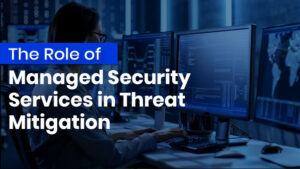
The Role of Managed Security Services in Threat Mitigation
The Role of Managed Security Services in Threat Mitigation Introduction In today’s hyper-connected digital economy, cybersecurity threats are not only growing — they are evolving
🚨 Just Launched! Ethical Hacking – AI Edition! Unleash the power of AI to master cutting-edge hacking techniques. Enroll Now!

The Role of Managed Security Services in Threat Mitigation Introduction In today’s hyper-connected digital economy, cybersecurity threats are not only growing — they are evolving

Top 5 Cloud Security Tools That Are Revolutionizing the IT Industry Introduction As businesses increasingly migrate their data, applications, and infrastructure to the cloud,

From Stress to Success: Let Managed Services Handle IT Introduction With the rapidly accelerating digital environment, organizations today depend on technology more than ever.
Table of Contents
The increasing growth of the Internet of Things devices alters how IT architects modernize their infrastructures. Indeed, the growth to the edge is so noticeable that Gartner By 2025, 75% of company data will be generated and handled outside of traditional data centers or the cloud, according to Gartner.
The unavoidable byproduct of this expansion is the temptation for bad actors to exploit edge device vulnerabilities and compromise data. Lateral attacks, account theft, entitlement theft, DDoS attacks, and other methods can cause new computing security threats and Service disruption. They provide a fundamental challenge to how security professionals deploy data at the edge to maintain a secure and reliable flow of critical information across the company. This article covers detailed knowledge of Edge Computing Security Risks and Challenges in 2023.
Check Out Our Cloud Computing Courses Now!
Edge computing refers to processing data closer to its source or the “edge” of a network rather than relying on centralized cloud servers. This approach reduces latency, conserves bandwidth, and enhances the real-time processing capabilities of applications and devices. There are several types of edge computing, each suited to different use cases and scenarios:
By introducing a hierarchical method, fog computing expands on the concept of edge computing. It deploys computer resources (such as servers, routers, and switches) at multiple network levels, such as the edge and the cloud. This allows for localized data processing at multiple points in the network.
MEC focuses on bringing computing resources closer to mobile users and their devices. It enables low-latency services for mobile applications and is particularly relevant for 5G networks, where ultra-low latency is critical for applications like autonomous vehicles and augmented reality.
A cloudlet is a small, lightweight data center or server located at a network’s edge. Cloudlets provide computing resources to nearby devices and applications, which reduces latency and improves the user experience.
Industrial edge computing is tailored to manufacturing and industrial environments. It enables real-time data processing and analytics for Industrial IoT (IIoT) applications, optimizing production processes and enhancing automation.
IoT edge computing focuses on processing data generated by Internet of Things (IoT) devices at or near the source. This reduces the need to transmit vast amounts of raw data to centralized data centers, saving bandwidth and enabling faster decision-making.
In retail, edge computing can enhance customer experiences through personalized recommendations, inventory management, and in-store analytics. It can also improve supply chain management.
Healthcare applications benefit from edge computing by enabling real-time monitoring of patients, processing medical data at the point of care, and ensuring data privacy and security.
Edge computing plays a crucial role in building smart cities. By processing data obtained from sensors and cameras located around the city, it is possible to control traffic, public safety, trash management, and other urban services.
Edge AI involves deploying machine learning and AI models directly on edge devices or servers. This enables real-time inference and decision-making without relying on cloud-based AI services.
In retail, edge computing can enhance customer experiences through personalized recommendations, inventory management, and in-store analytics. It can also improve supply chain management.
Autonomous vehicles rely on edge computing to process sensor data and make split-second decisions, improving safety and reducing latency.
Edge computing can enhance online gaming experiences by reducing lag, enabling real-time interactions between players, and providing localized game servers for faster gameplay.
The practice of securing the network perimeter or edge of a computing infrastructure is referred to as edge security or edge cybersecurity. It focuses on safeguarding a network’s entry and exit points, where data and traffic are often exchanged between several devices and users. The organization’s digital assets and sensitive information are protected from external threats like hackers, viruses, and unauthorized access due to edge security, which is a crucial component of total cybersecurity.
Edge computing offers many advantages, such as reduced latency and improved application performance, but it also introduces unique security risks and challenges that must be addressed. Here are some of the critical security risks and challenges associated with edge computing:
Edge devices are often distributed across various physical locations, making them vulnerable to physical tampering or theft. Ensuring the physical security of these devices is crucial.
Edge devices are typically connected to the internet or local networks, which can be susceptible to network attacks. Due to the scattered nature of edge computing, it might be difficult to monitor and safeguard all network connections efficiently.
Edge computing often involves processing sensitive data at or near the data source. Ensuring the privacy of this data is critical. Any breach or unauthorized access at the edge could have severe consequences.
Edge devices may have limited computational resources and may not receive regular security updates. This makes them attractive targets for attackers looking to compromise these devices for use in botnets or other malicious activities.
Managing authentication and access control for edge devices, especially in large-scale deployments, can be challenging. Ensuring that only authorized organizations can access and control these devices is critical.
Data transmitted between edge devices and centralized servers must be protected to prevent tampering or interception. Ensuring data integrity is essential, especially when dealing with critical data.
Edge computing introduces a distributed attack surface with many potential entry points for attackers. This makes it essential to implement security measures at each edge device and effectively manage security across the entire network.
The edge computing landscape is still evolving, and there needs to be standardized security protocols and practices. This can lead to inconsistencies in security implementations and potentially create vulnerabilities.
Edge devices often have limited computational power and memory, which makes it challenging to implement robust security measures. Balancing security with resource constraints is a significant challenge.
During data transmission, communication between edge devices and the cloud or data center creates possible security issues.
Encryption and secure communication protocols are essential to mitigate these risks.
Managing and monitoring security across many distributed edge devices can be complex. It’s essential to have adequate security management tools and processes in place.
Different vendors may provide edge computing solutions with varying levels of security. Organizations must carefully evaluate and select vendors, prioritizing product and service security.
Edge computing is a strong technology that provides numerous exciting opportunities for enterprises. However, to ensure the safety of data and devices linked to an edge computing system, security risks and problems must be addressed. Fortunately, these dangers can be mitigated by proactively establishing or managing an edge computing network that employs secure protocols and best practices. With the appropriate approach, organizations can maximize security while benefiting from this disruptive technology.
To address these security risks and challenges, organizations adopting edge computing should develop a comprehensive security strategy that includes encryption, access controls, regular security updates, intrusion detection systems, and monitoring solutions. Additionally, ongoing security training and awareness programs for personnel are critical to maintaining a secure edge computing environment.
© 2025 All rights reserved | Privacy Policy | Terms and Conditions | Sitemap | Cookie Policy




